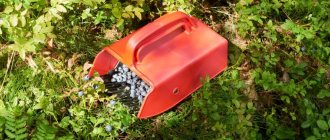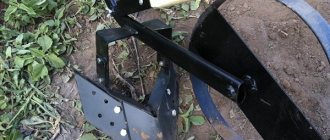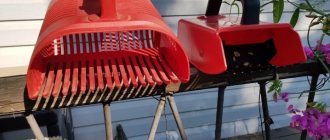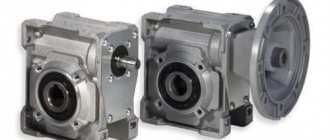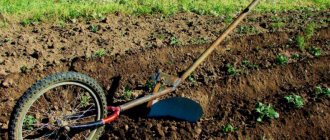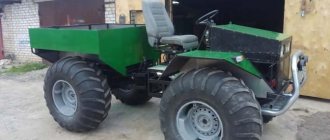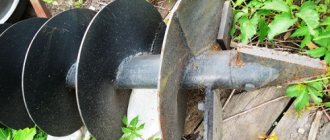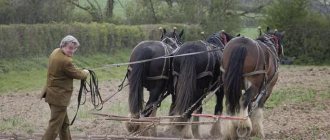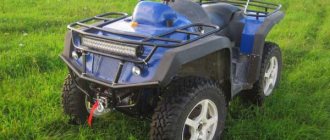Wild forest berries are good for health and contain a rich set of vitamins, but picking them by hand is a huge physical labor that requires good health and a lot of free time.
A simple device for picking blueberries, which I show with three simple designs, can reduce the load on the body and significantly speed up this process.
Their design, materials and manufacturing technology are different, which affects the process of harvesting berries. Therefore, get to know everyone and choose the option that suits you best.
Picking berries by hand
Unfortunately, the remoteness of the berry patches significantly complicates their collection. Swampy terrain, forest wilds, mosquitoes and midges also do not add pleasure to this process. But the main difficulty lies in the size of these berries; it rarely reaches 10 mm, and in the northern regions it is even less. Historically, picking wild berries was done by hand, so the fruits are less damaged and fewer leaves and twigs end up in the baskets. However, this method has very low efficiency; even an experienced berry grower in a good year may need more than one hour to fill the coveted bucket. A less agile picker would hardly fill a bucket in a day.
Advantages and disadvantages
The big advantage is that it simplifies collection and increases the speed of work. Even homemade units will allow you to work several times faster, and in 7-8 hours a novice assembler will be able to collect 12-15 kg. Very impressive numbers when compared with the bare-handed collection method.
Another plus is the low price. On average, berry pickers cost about 900 rubles. You can recoup this price on the first day or after several hours of work. You can make such a unit yourself, but for this you need to try.
The disadvantage of using a combine is the damage to berries and bushes. The thing is that when you pick leaves and young branches along with the berries, you make the bush less fertile. Such a sharp method of plucking has a bad effect on what the harvest will be like next year. In addition, you litter with leaves and debris that falls to the ground from branches.
How to use a combine harvester correctly
Even if the use of such devices for collecting wild berries is not prohibited in your region, it must be used with extreme caution
It is important not only to harvest as much harvest as possible, but also not to harm the plant. Under no circumstances should you pull the rake if it gets caught on leaves or branches.
Wild berries do not hold too tightly to the ground and by tugging with special zeal, you can simply pull them out by the roots.
You should not start picking until the berries are fully ripe. They, of course, can ripen outside the bush, but in this case they will quickly deteriorate and may acquire a bitter taste. In addition, unripe berries are more difficult to tear off and you again risk damaging the plant.
If a lot of leaves and twigs have accumulated in the “robbery”, do not rush to get rid of them. By brewing them with tea (or separately), you will get a wonderful drink full of vitamins and microelements.
Varieties
There are three types of berry harvesters: mechanical, vacuum and manual. They differ in operating principle, performance, and drive used. Mechanical berry pickers are used on farms for the industrial cultivation of fruit bushes. For one-time use, manual or vacuum designs are suitable. They are compact, lightweight, and can be used in any conditions.
Mechanical
Active harvesters are considered industrial special equipment designed for collecting berries on large plantations. According to their layout, mechanical assemblers can be self-propelled or trailed. The first are represented by independent devices assembled on a wheeled chassis. They are equipped with an internal combustion engine, transmission, and actuators. The working body, the comb, is designed to collect a certain type of berries, which forces the device to be reconfigured for different crops.
Towed mechanisms only work in conjunction with a traction machine. The working bodies receive rotation from the power take-off shaft located at the rear of the tractor. Trailed structures cost less than self-propelled ones due to the simplification of the device, the absence of an engine and transmission. The functionality of the units is identical: they can collect berries of different sizes, growing at any height.
Expert opinion
Stanislav Pavlovich
Gardener with 17 years of experience and our expert
Ask a Question
Interesting! Mechanical pickers do not pollute the earth. Grass, leaves and branches captured along with the fruits end up in a storage hopper.
Vacuum
To facilitate manual assembly, we developed a mobile complex that allows us to speed up the process and reduce physical stress on the user of the device. The vacuum berry picker is made in the form of a backpack that is worn on the back. It consists of a gasoline engine, a storage container, and a socket with a comb nozzle. The picking of blueberries or other fruits occurs due to the air flow, which captures the berries, carrying them into the hopper. The manipulator tube allows you to increase the grip area, eliminating frequent operator movements.
See also: Subtleties of blueberry propagation
Manual
Elementary devices consisting of a comb, container and handle are used in a private area or when collecting wild berries. They are made from plastic, metal or wood. Assemblers appreciate models from Finnish manufacturers: they are made of durable materials, which eliminates breakage and ensures long service life. Garden centers offer solid plastic structures. They weigh little, are not subject to rotting and corrosion, but are sensitive to mechanical stress.
What devices are there for picking blueberries?
A berry picker is a device that allows you to harvest large volumes of crops in a short time. The device has different operating techniques, differs in structure and level of mechanization. Here, the main thing is that the blueberry picking machine works efficiently and causes as little damage to the bushes as possible.
Among the variety of fruit pickers available on the market, we can separately highlight a list of models that are distinguished by their long service life, ease of use and additional capabilities.
Harvester K-1
This metal device from a domestic manufacturer has proven itself exclusively on the positive side. The device is chosen for its increased level of reliability and durability. It can be used for both blueberries and cranberries. During harvesting, the crop enters the container without any damage, intact and safe.
Harvesting berries is quick and easy
Bug
This blueberry picking machine is made of plastic. It is recommended to use it carefully, otherwise it may be damaged. This device is suitable not only for blueberries, but also lingonberries and cranberries. The dimensions of the device together with the comb are 13x23x15 cm.
The universal fruit picker harvests the crop quickly and efficiently
Pigasov combine
This design for harvesting blueberries is very popular among pickers. It is valued for its relatively inexpensive cost, versatility of use (currant, rosehip) and ease of use. The device is made of metal and galvanized wire, which acts as a comb. This scoop for picking blueberries is covered with a completely glossy paint, its weight is only 400 g, and its dimensions are 12x24.5x8 cm. The distance between the rods in the comb is 5 mm.
Budget berry picker with high productivity
Plastex
The device does not cause any difficulties during operation. It can be used together with a telescopic handle, which greatly simplifies the work of harvesting ripe berries.
Harvesting is easy and relaxed
Alko
The device is equipped with a removable handle and a bag for collecting small berries (cranberries, blueberries, lingonberries, sea buckthorn, currants, gooseberries). The device is made of high-quality materials, which explains its long service life. The blueberry picking machine consists of a handle-holder, a bag and a comb; they are made of plastic and textile.
The device easily attaches to a belt or backpack and has a comfortable handle.
Classification of berry harvesters
Based on the level of mechanization, all berry harvesters are usually divided into:
- Manual without mechanization of processes. The designers were inspired to create them by ancient prototypes that have been used on our lands since time immemorial, their appearance reminiscent of a short-handled rake with a bag or box tied to it. Nowadays these are very ergonomic containers with a handle, equipped with a wire or sheet palisade to grip stems or branches;
- Manual with mechanization of processes. On the modern market there are products held in the hand that use a motor for frequent translational movements of the removing block to crush the berries from the branch, or vacuum suction; 3. Automatic under operator control. Outwardly they resemble ordinary forage or grain harvesters, with the difference that they do not have mowing blocks or digging elements. And separation processes, taking into account the fragility of the product, have their own characteristics.
Based on available assembly volumes, industrial berry units and devices for home use and small farms are distinguished.
What is a blueberry harvester?
Before you make a device for harvesting blueberries, you need to understand what it is. A berry picker is a device that makes harvesting ripe berries much easier. With the help of such a combine, the harvesting procedure does not last several hours, but a matter of minutes.
The main element of this tool is the elongated teeth, which are shaped like ridges. The distance between the cloves is 5-8 millimeters, and the length of each of them reaches 25 centimeters. These sizes allow the comb to safely pass by the leaves and stems of blueberry bushes.
The next important detail of the product is a ladle equipped with a small handle. When harvesting ripe berries, the comb is positioned so that the teeth point upward. Then the structure is carefully pulled along each row. All berries will be automatically picked by the tines and placed in the bucket.
How and when to pick blueberries without damaging the berry plant: personal observations
I live in the middle climate zone, and I judge the beginning of blueberry ripening by observing the black currant fruits in the country. As soon as they begin to turn from brown to black, you can immediately head to the forest.
This usually happens at the end of the first week of July. At this time, the blueberry is not yet fully ripe; there are many small and green berries. It is not worth collecting them with mechanized devices: there is a lot of waste.
The leaves (like the fruits) stick very firmly to the bush and, when they get between the teeth, they crush and deform the berries, and when they come off the branches, they make picking very difficult. The garbage becomes saturated with juice and is difficult to separate.
During this period of time, I recommend abandoning any mechanisms and picking berries only with your hands. My speed is low: on average, I get a little more than 1 liter per hour, but it’s quite enough for home preparation and consumption, and I’m not involved in sales.
At this time, the collection is accelerated:
- a container for berries, made on the principle of a sippy inkwell, the ribbon of which I hang around my neck;
- cups on the fingers of each hand, saving the movement of the berry picker’s hands towards the container.
I consider the optimal time for harvesting with mechanized devices to be the end of July and August: blueberries are gaining strength, and the fruits, reaching their maximum size and the greatest amount of vitamins, have a pleasant taste.
It is during this period that I make my mechanized devices. Nowadays it’s not a problem to buy a factory-made blueberry harvester. But it is prestigious for a home craftsman to do it with his own hands, taking into account his individual abilities.
In this case, it is necessary to take into account a number of technical features that take into account the physical properties of the ripe berry. I include:
- fruit size;
- separation force from the stalk;
- the state of the juice and the crushing strength of the shell;
- presence of garbage.
How does fruit size affect puller design?
A ripe blueberry usually exceeds 6 mm in diameter.
I take this indicator into account by the gap between the teeth of the combine, choosing it to be at least 5 mm. It allows:
- cut off some of the underdeveloped fruits, leaves, needles, and other debris;
- collect only ripe varietal berries;
- do not damage the bush.
Which tooth shape is safer to tear blueberries from the stem?
Among industrially produced combines, designs with teeth made of round wire predominate.
It is more convenient to make them this way, but this does not have a very good effect when the berry is torn from the stalk. I showed this process in the figure. I share my observations.
At the round tooth, the fruit is pulled into the recess shown by the dotted lines and is slightly crushed. A flat surface immediately tears the berry away from the stalk, deforming it less.
In this case, it is important to avoid sharp edges at the ends, which can push through the thin shell. I do this by forming a very small chamfer on the ribs.
The width of the tooth also affects the operation of the device. A narrow profile fits better between twigs and leaves and creates less clustering. This reduces the formation of debris in the gaps and does not injure the ripened fruits and the blueberry itself.
How to reduce physical activity and keep your body energetic in the forest: 5 tips from an elderly berry grower
The following useful devices help me feel comfortable in nature:
- A mountain bike that allows you to cover a distance of about 15 km in half an hour on the highway and off-road. Thanks to the aluminum frame, it is lightweight and easy to carry through bushes and fallen trees. I always place it near the collection point.
- Folding chair. I sit on it and pick berries. The back is not subjected to physical stress.
- Factory made knee pads. They complement the functions of the high chair well.
- Old shoulder backpack. I carry the high chair and all my belongings in it, including a thin plastic raincoat in case of rain.
- One-liter plastic food buckets with lids. I pour blueberries from a ladle into them. I gave up buckets, even 5-liter ones, about 10 years ago: their height adds weight to the harvest, which puts pressure on the bottom layer of berries. The latter let out juice, which is bad. The container for soft fruits should be low and as wide as possible. I just take about 7 buckets, inserted one into the other. So they take up little space. I fill them two to three hours in advance, close the lids, place them in a food bag, tie them (insurance against spills when bending or falling) and go home.
If you forgot mosquito repellent ointment at home, it’s no problem. In such cases, my grandfather put a clean cloth (or a handkerchief) on the anthill, and after ten minutes he took it off. During this time, the fabric is saturated with formic acid.
It is enough to wipe open areas of the body and blood-sucking insects will not sit on this skin for several hours, and their buzzing is not scary.
Peculiarities of picking blueberries and strawberries
Picking blueberries and wild strawberries is a labor-intensive and painstaking process. The berries are small, the bushes are low and grow densely. Harvesting by hand is incredibly difficult—you literally have to pick one berry at a time from all the greenery. In this case, you need to stand bending towards the ground.
Blueberry picking
Most often, blueberries are found in pine and small-leaved forests. Finding a berry bush is quite simple: a clear sign of the presence of shrubs is a wild plant - wild rosemary. It has a distinct smell, which will become your guide.
There are also cultivated varieties of blueberries that gardeners grow in their summer cottages. The bushes of such plants are taller, but less common, and the berries are larger, and therefore it is much more convenient to collect them than forest ones.
Hand picking blueberries in the forest
Bushes can reach an age of 40 years. The oldest ones occupy a large area and have a spreading shape. They bear a lot of berries, but they are smaller than those on young plants.
The most delicious and healthy fruits grow on young animals, whose age does not exceed 10 years. They have thin green twigs, and thick side branches are practically absent.
It is recommended to collect blueberries in small plastic buckets or baskets. It is not worth pouring the harvested crop from one container to another, since the berries, although strong, are easily damaged. You should not pick blueberries after rain; it is better to choose dry morning weather.
Collection of forest and garden strawberries
Picking strawberries also has its own characteristics. Both a wild forest and a garden berry, it loves well-lit, open areas. Ripe and ready-to-eat fruits have a bright red color and are easily separated from the stalk.
Hand harvesting strawberries
The fruit cups can be removed immediately, or the berries can be sorted later. The best time to pick strawberries is in the morning, when the dew has dried. The fruits must be collected in small containers of 2-3 kg. It is not recommended to overspray; the berries are soft and easily damaged.
Device for picking cranberries while standing
Such a device can be made by a master who is fluent in tools. It is quite complicated, but you can use it to pick cranberries without bending over. All the parts of the box are cut out from a piece of thick plywood, as well as the comb strip.
The comb is easy to make:
- a number of holes are drilled in the plank;
- cut the wire into pieces of the required length;
- the teeth are fixed in the holes with glue.
Comment!
To prevent cranberries from spilling out during harvesting, install a movable plate.
The back wall of the bucket is made composite, the lower part is movable. It is attached to the top part on furniture hinges, and fixed to the side walls with pieces of rubber. This design allows you to stand and pour cranberries into a bucket.
To do this, one end of the rope is attached to the lid, the other is tied to a movable handle, which is bolted to a high handle made of 2 plastic tubes. Their length is determined empirically to make it convenient for the assembler.
Felling trees with a chainsaw
Tree felling technology and log sawing are concepts that every chainsaw owner should be familiar with...
Wooden choppers are hammered into the holes of the tubes, and plywood plates are screwed onto screws on the outside. The tubes are attached to the box using furniture corners and bolts. The connection turns out to be movable, which is very convenient when picking blueberries while standing. A narrow strip of plywood - a handle - is screwed to the top of the tubes. It is wrapped with soft cloth and electrical tape.
Vacuum cleaner for collecting chokeberry
You will need a corrugated hose from an old vacuum cleaner, a plastic beer bottle with a long neck. It needs to be cut so that there is a piece left for joining with the corrugation. In the lower part of the cylinder, cut a window in which the lower edge is decorated with teeth.
Cutting teeth is difficult; you need a sharp knife. Assemble the combine:
- insert a cylinder with a jagged window into one end of the pipe for collecting berries;
- Secure the joint with several turns of electrical tape;
- Attach a T-shirt bag to the second end of the corrugation with electrical tape.
Comment!
The T-shirt bag needs to be intact, without holes. Picked berries will fall into it.
The operating instructions for this vacuum cleaner are simple. Hold the branch with one hand, and use a ladle to pick off the chokeberry fruits with the other hand. They will roll down the hose into a bag.
Was the robber invented by a bear?
We do not know when and who figured out to carve the first such instrument from wood, but we can guess who inspired this person. Most likely a bear. Berry places attract this gourmet, whose clubbed limbs are quite capable of feeding the voracious forest hero. He manages them very deftly - he catches fish in the rapids, eats oats, and picks berries. It’s not for nothing that those bears that get into the habit of sown fields are called fescue bears. An eyewitness describes: “He sat down on his butt, put his paws into the oats and slashed up the stem with his claws, scooping all the oats into his mouth.” The same with berries: it’s not for nothing that the long teeth of a rake are so similar to the clawed paw of a bear
Careful handling of rakes made it possible to take care of the berry lands. In order not to harm the plant, the “claws” were carefully threaded through the branches of the berry bush near the ground and shook slightly so that the berries fell off and the leaves were not damaged.
The shape of the instrument carved from wood depended on the imagination and diligence of the master. The rakes could be very simple, utilitarian, or intricately decorated with paintings or carvings.
DIY rake
Those who decide to make a rake themselves will immediately understand that this tool consists of only two parts: a handle and a transverse bar mounted on it.
Cutting
The cutting is made mainly from wood. For this they most often use:
- pine, which is not afraid of moisture, and is also quite strong and light;
- birch, easy to process and light in weight;
- beech, famous for its good strength, but requiring additional processing;
- oak, which, although durable, can only be used by strong men due to its heavy weight.
The finished piece of shoot is sharpened on one side and the other cut is sanded. The handle should not be painted or cleaned, as it will slip and turn in your hands when used.
Transverse work surface
At home, the easiest way to make a working surface is a rake from wood from scrap materials. The same types of wood that were considered in the manufacture of the holder are suitable for this. For a better result, it is best to first make a drawing of the proposed model. This will make it easier for you to navigate the process.
The process of manufacturing a bar with teeth consists of several successive steps.
- From a block 5 cm wide you need to make a block 3 cm high and 50-60 cm long.
- In its center, on the side of the width of the bar, make a hole, the diameter of which will coincide with the diameter of your cutting.
- Using a thick drill, make holes in the workpiece for the working surface along the width of the block. The distance between them should be 35-40 mm.
- From a suitable material, make blanks for teeth 10-11 cm long and with a diameter equal to the width of the prepared teeth.
- For ease of use, each tooth should be sharpened on one side.
- Insert the teeth into the holes prepared for them with the blunt end inside the bar and secure with self-tapping screws on the side of the block height.
Homemade cross rake is ready. They are suitable for collecting leaves, hay, and cleaning the lawn. With light loads and proper care, the tool will serve you usefully for a long time.
Drawings and dimensions
For blueberries, gooseberries, cranberries and lingonberries, the simplest ladle with a recess is suitable. A comb with teeth 10–15 mm long, which are spaced 4–5 mm apart from each other, is attached to the front. The back of the bucket is equipped with a handle for more convenient operation. The berries are easily picked from the bush and rolled into a container, and then they can be poured into a bucket or other container.
The parameters of such a berry picker will be as follows:
- base in the form of a rectangle with sides 72 and 114 cm;
- sidewalls that bend U-shaped according to the drawing below;
- comb teeth 2 mm thick and 10 mm long;
- the distance between the teeth is 5 mm.
Figure 1. Drawing of a metal berry picker
This is due to the fact that their leaves are too large and do not fit well between the comb teeth. It is recommended to collect strawberries on a large scale using commercial berry pickers-vacuum cleaners, which cause minimal damage to the delicate trunks and tendrils of the plant.
Questions and answers
Do manual harvesters damage the stems and branches of shrubs?
Depends on skill. An experienced berry grower does not use force when picking berries with a hand harvester. As much as possible, it can only catch leaves that will grow again next year.
Is it possible to pick strawberries and raspberries with a hand picker?
Alas, strawberries and raspberries will become wrinkled and lose their appearance. They can only be collected by hand or with special agricultural machines.
Is it true that the law prohibits the collection of wild berries with manual and vacuum harvesters?
There are no laws in Russian legislation prohibiting the use of berry pickers. Careful and careful handling of plants does not depend on how to pick the berries - with tools or by hand.
Which berry picker causes less harm to nature—manual or vacuum?
When used correctly and carefully, manual and vacuum fruit pickers do not damage the stems of blueberries, cranberries, lingonberries and other forest plants. All factory-produced models have been tested to confirm their safety.
What do cherry and raspberry harvesters look like?
Cherries and raspberries are harvested mechanically. Combines are similar to grain harvesting agricultural machines, modernized for berry picking.
Manual, vacuum and mechanized berry pickers help harvest crops, saving time and human effort. If you don’t like to walk for a long time in the forest or devote all your days to gardening, then you need to choose a convenient option from a variety of models of fruit collectors and forget about the inconvenience.
How to make a homemade tray-harvester for picking berries with your own hands
Experts consider this model the most convenient. For production, plywood, leftover boards, and chipboard are used. The manufacturing process is simple, even beginners can do it. Stages of work:
- Markings are applied to the plywood according to the selected drawing. The parts are cut according to size: bottom – 22*10*1.3 cm, top – 15*12*0.7 cm, sides – 20*9*0.7 cm, 2 pieces, cap – 10*9*0.7. Teeth 5 mm wide are cut out at the bottom at a distance of 5 mm.
- The side parts are cut down so that it is longer at the bottom and shorter at the top. All elements are painted with stain and covered with 2-3 layers of varnish.
- The parts are connected according to the diagram into a single structure. Assembly is carried out using wood screws and a screwdriver.
- Cut out the handle and partition from sheet steel. The attachment points are bent to the desired shape. The handle can be made from a board 3 cm thick and 8 cm wide.
- To allow the partition to move freely, the upper part is bent around a nail and secured with bolts.
Details
The combine will consist of two side parts, a bottom with teeth, a back part and a top. It is also worth installing a partition that will prevent the berries from falling out.
The lower part will be rectangular. Cuts are made on one edge with a circular saw. Their length should be about six centimeters, with a gap of five millimeters between the teeth. If you have a grinding machine, you can make an improvised bend of the teeth.
The sidewalls must have one oblique cut. The bottom part will be longer than the top. Next, the lid and rear wall are made according to the dimensions of the combine.
In order for the collected berries to remain inside the device, it is necessary to install a latch on the front wall. It can be made from soft iron, plastic or rubber. This part is mounted on bolts in such a way as to be able to open. The back should also open so that the berries can be unloaded into the container.
How to make a cranberry harvester
Two years ago I came across a cranberry Klondike near my house. Well, it's close. ten kilometers with convenient transport. The cranberries were really lying there like a carpet, and in a few days I mowed 200 liters with a simple blueberry harvester. I also ensured the production of delicious liqueurs for the winter, froze the berries for fruit drinks, distributed them to friends and relatives, and sold some to neighbors. In half a day, spitting, I filled two twenty-liter buckets.
Remembering this wonderful place, last year I built a special cranberry harvester for the season in order to collect the same amount not in five days, but in two. But, as is usually the case, man proposes, but God disposes. That year there were no cranberries in the Leningrad region - they drowned during the rains. For those who don’t remember, it rained 60 days out of 90 that summer. In general, I put off the combine until this year and now I’ll tell you a little about it.
A few words about the swamp. This is the northern part of Lake Sestroretsky Razliv - it is swampy and there is a bird sanctuary there. Over there on the horizon is Sestroretsk:
All sorts of rare ducks and seagulls nest in the swamp. The swamp is raised, not swampy. But entering it from the north is absolutely hellish (that’s why there are always few people there). Right near the shore in the water there is an impenetrable bush - willow. The water is approximately knee-deep, in some places up to the testicles. In a wet year you can’t get through there without wading boots. Deep holes, tall grass, high hummocks. Entering light is still tolerable, but going out with a load without knowing the trail is hell. The first time I left there with two full buckets in my hands and without a pole. An hour passed for a hundred meters.
The berry grows on small islands. Here is a mossy cranberry island. Where the grass is tall, the water is knee-deep.
Here's another island:
There are probably a hundred of them there.
And now, actually, about the miracle of technology.
I got the idea from the Toropushka combine harvester. I copied the shape from photographs, estimated the dimensions and made it from what I had. Sheet aluminum was expensive, there was no good sheet iron at hand either, so I made it from PVC plastic. For these purposes, I bought an orange sewer pipe, sawed it lengthwise with a jigsaw, heated it with a hair dryer and straightened it. The needles were bent from thin electrodes. As it turns out, the bending of these spokes is one of the main components of a proper harvester. The first time I bent it wrong, I lost a day in the swamp and had to be redone. The handle is also a piece of PVC pipe. The berry picking sleeve is a regular construction bag. We should find something easier, but that's it for now. By the way, the sleeve must be made of durable synthetic fabric - it shuffles on the grass and the cotton fabric will quickly wear out.
The plastic turned out to be thick. Firstly, it is extra weight, and secondly, it does not push through moss as effectively as thin metal. But, as they say: without fish you will become a cancer yourself. If I have the mood and the material, I’ll redo it in the winter.
Harvesting with this combine differs from harvesting with blueberry scoops. With this combine you row towards yourself, not away from you. The initial movement is almost vertically downward. We push the moss, pull it towards ourselves, gradually turning the combine with a brush. The final movement is to pour the berries into the sleeve.
The harvester takes approximately 80% of the berries per pass.
Here is the original bump.
After one pass.
There is no need to try to collect all the berries - this is extra effort. We only take cream. The food processor does not work well in thick grass. Yes, it practically doesn’t work at all. There are other devices for these purposes; for example, a regular Finnish blueberry processor does a good job. But there are also cranberry ones. They have low productivity for open berries, but they can be picked from hard-to-reach places. And this harvester is for berries lying on the surface. In good places and with good harvests, it rows wheat like a Don 1500. One hundred kilograms a day of such stray food is quite realistic.
There was no summer this year. There are cranberries in the swamp, but not in the quantities expected and for which the harvester was made. If searching for a berry mound takes more time than picking berries from it, then it doesn’t matter what you pick - either with your hands or with a blueberry harvester. In general, I scooped up ten liters and headed home. I'll wait until next year and at the same time I'll remake the sheet metal harvester.
While getting ready to go to the swamp, I picked up a Finnish easel backpack for 500 rubles at a second-hand store. I took off the backpack and left the cargo frame, which turned out to be quite a decent little thing. The sneaker in the photo is for size.
The bag contains cranberries, a food processor, a bottle of water, a jacket, and sneakers.
Similar designs: rakes, scoops, shovels, combs and others
The principle of “picking” berries from herbaceous bushes is implemented in some devices, either simpler in design, or designed to further simplify the work of the picker.
For example, the simplest options are ordinary wooden scoops with long teeth on the leading edge:
Some of their options are simplified as much as possible:
And some homemade models strike an excellent balance between simplicity, cheapness and functionality. For example, here's a combine:
It is made of wire, thread and a bag, but is very compact and is not inferior in ease of use to industrial options.
In these cases, the typical combine design is simplified for the fastest possible production. However, these options have their drawbacks. For example, the scoop has low sides and if accidentally tilted, the berries easily spill out of it. And wooden ladles get dirty quickly.
In other cases, inventors are working to make it possible to use a harvester to pick berries without bending over or crawling through the forest on your knees. The simplest option in this case is a special rake:
They can be used to comb the bushes without bending over, from time to time pouring the collected berries into a bucket.
A more complex option is to combine a rake and a combine. Simply put, the combine has a long handle that allows you to change the angle of the bucket itself. The video shows an example of such a device:
And, by the way, please note: even such complex designs can be made with your own hands. And if manufactured correctly, the resulting combine will be no worse than an industrial one
Therefore, it is worth saying a few words about how to correctly implement the basic principle in such a product.
Manufacturing instructions
From funds found at home, homemade devices for collecting forest gifts are made without drawings. The dimensions and shape of the devices determine the dimensions of the plastic products (bottles, containers) from which the bucket is made.
More complex products made from materials such as metal, wood, plywood are made strictly according to the scheme. First, patterns of all parts of the device are drawn on paper or cardboard, then they are transferred to metal or plywood sheets.
From sheet metal
A step-by-step description of the process of making a blueberry harvester with your own hands will help you in your work:
- take a galvanized sheet and apply the contours of the bucket body parts onto it according to a template;
- cut out all elements of the future design with metal scissors;
- Cut rods from wire (1-3 mm), at the comb of the scoop they will be the bottom and teeth;
- connect the body parts with rivets;
- Attach a curtain inside to the hinges; it will prevent the fruits from spilling out when picking;
- make a handle from a piece of pipe, flatten the ends and rivet them to 2 bent strips;
- Rivet the holder with handle to the body.
For the berries, sew a bag from coarse fabric and attach it with thin wire or rope to the body of the bucket. Bend the spoke teeth of the comb smoothly upward. How to fix the comb spokes is worth considering in detail.
Note! To make the hand comfortable, the steel handle is wrapped with several layers of electrical tape.
First, cut out 2 strips of galvanized steel, 3 cm wide and equal to the width of the comb. Fold each strip in half and cut 2 cm from each side of one half. On the fold, mark locations for holes with a pitch of no more than 5 mm.
Make cuts exactly according to the markings using an emery wheel. Insert wire into the holes of the first and second plates and solder them so that they do not fall out. Using a chisel and hammer, shorten the spokes to the same length and bend them.
Made of wood
Make a device for collecting berries from thick 9 mm plywood. Make a comb from old bicycle spokes or 3 mm wire. Place the templates of the body parts on a sheet and outline the contours. Using a jigsaw or hacksaw, cut out the blanks strictly along the drawn lines.
To make a comb, take a 18 * 18 mm strip and cut 2 bars. On each, along the center line, mark the locations for the holes with a pencil and drill. Maintain a distance of 5 mm between adjacent holes. Make comb teeth from wire:
- cut into equal pieces;
- bend each rod in half so that the edges of the teeth are rounded and do not injure the stems when harvesting;
- insert wire blanks into the holes of both bars.
Bend the comb teeth to the desired angle. Assemble the bucket parts according to the diagram. Attach the door handle to the upper wall of the housing.
From a plastic bottle
You can make a ladle from a plastic bottle in the forest if you have a knife, string and a marker with you. The volume of the container does not matter - the more, the better. The workpiece must be placed on the ground on the side that faces up, and the outline of the hole must be drawn. It should repeat the silhouette of the English letter “W”. Use a knife to cut a hole.
Make a stick of the required length from a thick branch. Attach it to the neck of the bottle, secure it with a rope or several layers of electrical tape. The instructions for using this comb are simple:
- holding the stick, pull the device through the bushes;
- sharp edges will cut off the fruits, which will fall into the container;
- Pour the berries into the bucket through the neck, having first unscrewed the lid.
It is better to make the hole closer to the bottom, the plastic in that place is denser, the edges of the teeth will be harder.
From a canister
To make the body, take a canister with a volume of 1-2.5 liters. Make the part without a handle the bottom. Cut teeth and transverse slots in it to filter out debris. For convenience, draw all the lines on the canister with a marker.
Cut holes with a construction knife. Maintain the standard interval between the knitting needles – 5 mm. When picking fruits, hold the scoop by the handle. To save time on pouring berries into the body (bucket), attach a bag or fabric bag to the opening of the canister with electrical tape.
Required tools and materials
Do-it-yourself berry harvesters are made from plastic bottles, cans, plywood, and metal. The set of tools required for the job determines the material. When working with galvanized steel and wire use:
- hammer;
- metal scissors;
- welding or tin, flux and soldering iron for soldering;
- emery wheel;
- drill;
- chisel;
- pliers.
To build a harvester from wood (plywood) with your own hands, you will need a circular saw or jigsaw, a grinding machine or sandpaper, self-tapping screws, a drill, and PVA glue. The easiest way to work is with plastic. To work with this material, a knife and scissors are enough.
How to make a blueberry harvester
The device is assembled from plastic, wood, and metal. The berry collector is a box-shaped scoop or a cloth bag. The main working mechanism of the combine is the comb. The optimal length of the teeth is 6 cm. The width of the gaps is 5 mm. The comb can be adapted from a store-bought comb or made independently. Typically, the material for the teeth is steel wire or wooden kebab skewers.
Watch the video for more details about the homemade harvester:
Grabber for picking blueberries from a metal sheet
A durable combine is made from thin stainless steel sheets. In extreme cases, galvanizing is suitable. Consists of a scoop for collecting blueberries from a ladle and a handle. To manufacture the first element, perform the following steps:
- A rectangular blank is cut from sheet steel. According to the drawing, the stiffener is bent. On long curved shelves, holes are drilled in increments of 5 mm, into which wire teeth will be inserted.
- Following the drawing, a housing element is cut out of metal. The side shelves are bent, forming a U-shaped blank.
- The teeth of the combine comb are made of stainless, bend-resistant wire 2 mm thick. The elements must have the same bend. It is more convenient to bend the teeth on a wooden template.
- The last element of the combine bucket is the mounting block. A wooden strip 10 mm thick is drilled every 5 mm. The fastening bar will have teeth inserted into it.
When assembled, you should get a bucket, but for now without a handle.
For the handle of the combine you will need a piece of aluminum or metal-plastic pipe. The workpiece is bent in the shape of a “U”. A wooden round handle is put on one end. The second end of the pipe is inserted into a hole drilled in the center of the block. Its size is equal to the parameters of the fastening bar for the teeth.
When all the components of the combine are prepared, assembly begins. First, the bucket is assembled. The body is connected to a stiffener and a fastening bar. Self-tapping screws and rivets are used for fixation. Wire teeth are placed in the holes with glue so that they do not fall out. The handle is attached with a block to a fastening block fixed on the bucket. Two wooden elements are tightened with self-tapping screws.
A ready-made scoop for picking blueberries is tested in action. If the teeth seriously injure the blueberry branches, check the gaps. Perhaps some elements are bent and tightly pinching the shoots.
Wooden blueberry picker
A simple DIY blueberry harvester is made from plywood. Essentially, the device resembles an excavator bucket. 5 blanks are cut out of plywood: side elements of the same shape and size, top cover, back plug and bottom comb. Four fragments can be easily cut out with a jigsaw. The difficulty lies in making the fifth part - the comb. On a rectangular piece of plywood, teeth are precisely marked with the same gap. Each cut is made carefully so as not to break the comb element.
The blanks are connected to each other with self-tapping screws. A U-shaped handle is attached to the top cover of the combine bucket. It is made from a thin tube or steel plate.
Blueberry harvester from a plastic bottle
A primitive harvester can quickly be built from PET containers. The bottle will act as a fruit collector for blueberries and a comb. If you come across a fruitful bush while walking in the forest, but don’t have a combine harvester with you, you should look in your backpack. Ketchup, kefir or other bottled product taken on a picnic will have to be used quickly. If you have a choice, it is advisable to take a rigid container with a wide neck of small volume. Additionally, you will need a stick, which is not in short supply in the forest, a piece of rope or tape. Tools you need are a knife or scissors and a marker.
Having laid the bottle on its side, use a marker to draw a window in the form of a flag on the side wall. The working side, with its teeth directed towards the bottom of the container, is shaped like the English letter “W”. According to the marking, a fragment is cut out with a knife or scissors. The edges of the comb are sharp enough to cut blueberries. The stiffer the wall of the bottle, the stronger the comb will be.
The cut out fragment is thrown away. It is not needed for the combine. The bottle is tightly tied to the stick with the bottom up. It is advisable to use tape. The bottle will slide off the rope. Harvesting is carried out by pulling the device along the branches. A sharp blueberry comb cuts the berries with three teeth, and they roll into the neck of the bottle. When the fruit collector is full, unscrew the plug. The berries are poured into the bag through the wide neck.
Wooden skewers combine
A folk food processor is made from a set of wooden skewers on which shish kebab is skewered. The base of the bucket is two pieces 10 mm thick, sawn from a log with a diameter of 120 mm. One nickel is left whole. The middle is cut out in another blank. You should get a ring with a side width of 15 mm. In both parts, holes are drilled with a diameter 1 mm larger than the thickness of the skewers. It is important to maintain symmetry. It’s more convenient to put the ring on a dime and drill two parts at once. Through holes are made in the ring, and non-through holes are made on the coin.
Assembling the combine begins by inserting skewers into the holes of the coin. All elements are placed on glue. Place a ring on top of the protruding skewers, move it closer to the middle of the glass to form teeth, and fix it with glue.

